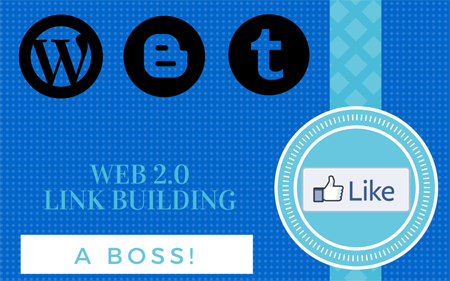Web 2.0 Link Building Strategies - Effective in 2015?

With the recent buzz around ensuring your website is mobile ready, social signals and other factors that influence your rankings, it is easy to put link building on the back burner. Although several types of links are now ineffective or even harmful, the effectiveness of a good link building strategy cannot and should not be overlooked.
When done correctly, Web 2.0 link building can still work very well and while these links alone are not going to help you dominate a competitive vertical, they can make a huge impact on local search and in less competitive spaces. Today we are going to look at how to set up an effective Web 2.0 site.

Selecting a Property
There are a ton of places that allow you to set up a blog. Here are three good platforms to get started with:
- Wordpress.com
- Tumblr.com
- Blogger.com
Regardless of which Web 2.0 platform you choose, taking the time to set up the site properly is what is going to set your blog apart from others using a similar approach.
Setting up an Account
The first thing you are going to have to do is set up an account with the three platforms. In the past people have suggested using different email addresses, IPs and other methods to disguise who is setting up the blogs. Fortunately, since we are setting up a blog that is useful, we do not need to add those extra steps. All you have to do is use your email and sign up for an account.
Selecting the URL and Page Title
At this step you need to consider whether or not you would like your Web 2.0 property to be capable of ranking for a specific keyword or phrase. Unlike a personal website, having an exact match (or near exact match domain) is actually helpful in ranking the property. If you are going to set up three sites, I would choose the most important keywords and use one of them in the URL of each site.
You can change the page title at any point but as a rule of thumb, it should at least include the primary topic you are going to blog about.
Adding Content to Your Blog
The days of adding a single post, dropping a link, and moving on to the next site are over. If you want your site to gain authority, have topical relevance and help your rankings, you are going to need some good content. Here is what I suggest at minimum:
- Add an about page with 2-3 paragraphs about the blog and writer.
- Add 10 Posts, each more than 500 words and original to your blog.
- Share videos, infographics, slide decks that are topically relevant (be sure to include attribution link).
Optimizing the Content You Add
Just as you would for your own website, you want to make sure your content is properly optimized. Here is a quick look at how to do that.
- Determine a primary keyword for the article.
- Find 3-5 LSI keywords to include in the article.
- Include 1-2 images in each post with KW relevant file names and alt text.
- Include 5-10 tags with each post (helpful on Web 2.0 blogs).
Scheduling Your Content
It is important to note that adding content to your site over several weeks is preferable to doing so all at once. If you are using the bare minimum recommendation of 10 articles, you should post two per month. In between the two original posts, you can add syndicated videos, images, etc., on a weekly basis to keep the site fresh. Adding some form of content once per week is more than enough. Each of the platforms mentioned above will allow you to schedule your content to post in the future, so take the time to find and schedule it all at once and you are free to move on to the next site. I would suggest adding your link to one of the original posts after about four weeks.
Increasing the Power of Each Blog
Once you have your new blog setup, you should look into increasing the authority of your blog. This will increase the value of the link you build to your site and will increase the likelihood of ranking the Web 2.0 blog for a keyword or two as well. In a recent post I discussed where to get your first 44 back links, it will get you started if you are not sure where to begin. Remember though, since you are adding quality posts to your blog, you can promote it the same way you would your primary website.
With just a little time and effort you too can set up your own Web 2.0 site and increase your online presence. For a local business, that could translate into a lot of new customers!
What about you? Any success stories with Web 2.0 link building?









